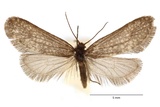Dahlica lichenella (Linnaeus, 1761) Species
Last modified: Jan. 18, 2025, 3:34 p.m.
The distribution of this parthenogenetic form is not sufficiently known due to the difficulty of this genus, but the species is believed to be rare.
Consensus about D. lichenella and D. lazuri is unclear for the moment, it may be about one species that has adopted different biology in different populations.
Details
- Classification
- Family: Psychidae > Subfamily: Naryciinae > Tribus: Dahlicini > Genus: Dahlica > Species: Dahlica lichenella
- Vernacular names
- Algenzakdrager (NL), Algen-Zwerg-Sackträger Zweigeschlechtlicher Zwerg-Sackträger (DE)
- First mention in Belgium
- De Crombrugghe G. 1907a. Observations sur quelques larves de microlépidoptères des environs de Bruxelles. — Revue mensuelle de la Société entomologique namuroise 7: 11–12. On page 12 (as Solenobia lichenella L.). view page
- Status
-
Native
Distribution
Imago
In parthenogenetic species, adult females are apterous. They can be distinguished from females of Dahlica triquetrella by the foreleg which in D. lichenella always has 4 tarsal segments, sometimes fused, whereas in Dahlica triquetrella there are always 5 tarsal segments.
Case
A cross-section of the case is round; this character distinguishes this species from Dahlica triquetrella in which the cross-section of the case has a triangular shape.
Flight periods
One generation a year from March till April.
Observed on
- Substrates:
- Lichens, Mosses and Dead leaves
The larva lives on lichens and mosses growing on tree-trunks, rocks and old walls.
Habitat
Forests, gardens, and parks.



